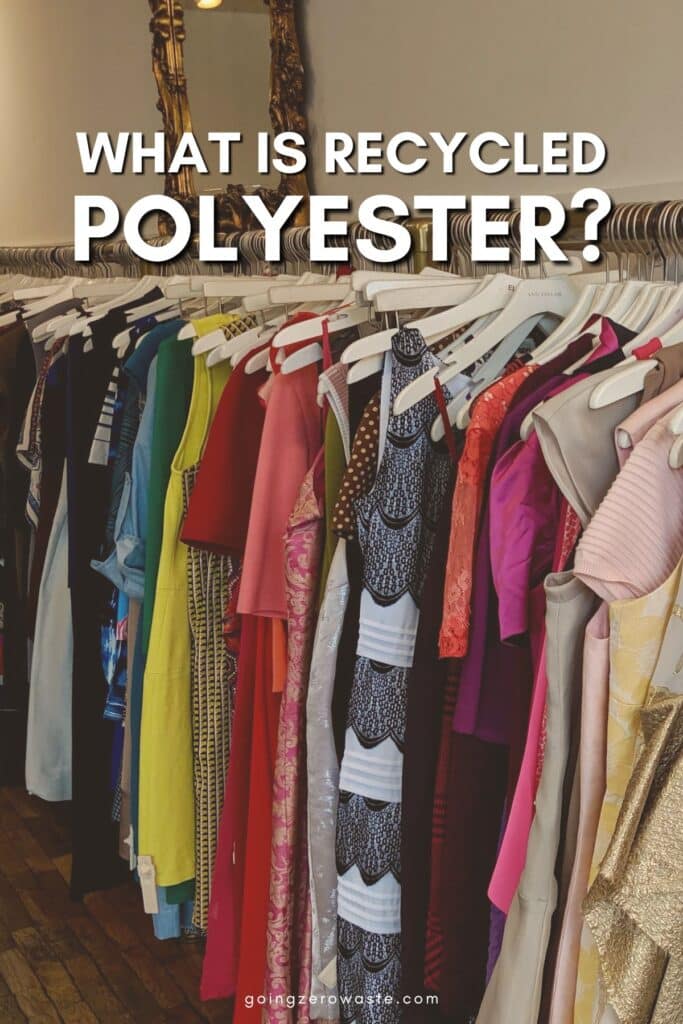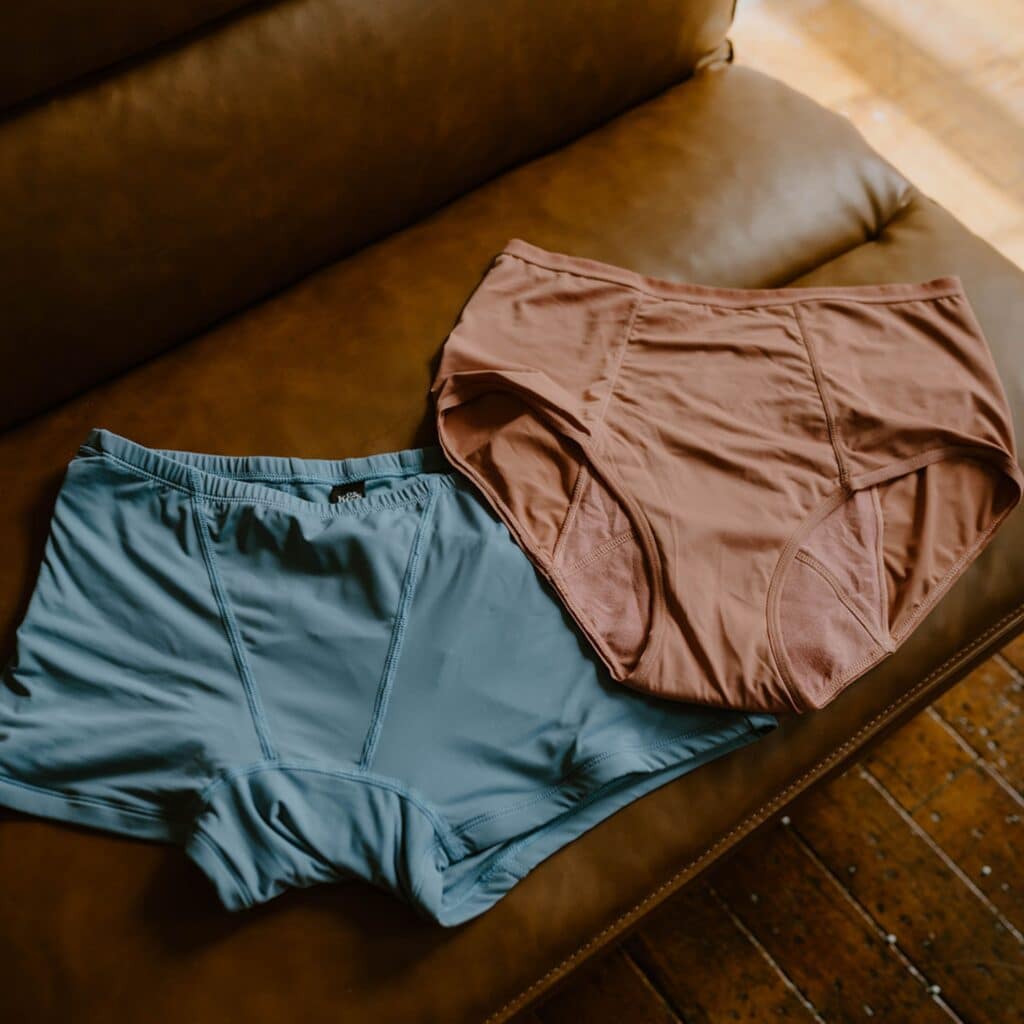[ad_1]
Last Updated on April 10, 2025
You’ve probably heard of polyester fabric before: It’s commonly used to make clothes and home furnishings. But what is it and how does it compare to recycled polyester? Which is more sustainable?
Personally, I try to opt for natural fibers whenever I can. Synthetic materials shed microplastics over time, aren’t as durable, and can’t be composted at the end of their life. Plus, I don’t really like how synthetic materials feel on my skin.
However, there are certain items that are harder to find synthetic-free, like athletic-wear and period underwear. These clothing items tend to need synthetics to offer stretchability and enhance performance.
When I first started going zero waste, I wanted to live a completely plastic free lifestyle, even free of recycled plastic. But then I started learning a lot more about recycled plastic materials, emissions and looking at the bigger picture.
Recycling plastic, like recycled polyester, definitely has its place in the sustainability movement. If you’re wondering which is better for the environment, here’s everything you need to know.
what is polyester?
Polyester is a synthetic fabric made from petroleum-based chemicals, specifically polyethylene terephthalate (PET). Petroleum (aka crude oil) is a non-renewable material that is often extracted from the earth unsustainably.
To create virgin polyester, 70 million barrels of oil are used annually, and turning this oil into fabric releases a lot of toxins into the environment.
However, most of our clothes are made of polyester because of how cheap it is to make. If you check a clothing label, chances are it will contain a certain amount of polyester in it.
Polyester is non-biodegradable, meaning it can take hundreds of years to decompose in landfills.
Its widespread use in fast fashion exacerbates the issue, as discarded garments often end up as long-lasting waste. Not so fun fact: We have enough clothes on the planet right now to for the next six generations!
what is recycled polyester?
Recycled polyester, often referred to as rPET, is made by repurposing existing plastic waste, such as used PET bottles or discarded fishing nets. This process reduces the need for virgin raw materials and diverts plastic waste from landfills and oceans.
The production of rPET uses significantly less energy compared to virgin polyester and results in lower greenhouse gas emissions. It’s a step towards a circular economy, where materials are reused rather than discarded.
Kayaness, a sustainable period company I co-founded with Shelby Orme, utilizes recycled polyester. The period underwear is made using ethical manufacturing and undergoes rigorous testing for safety.
Plus, period underwear is reusable and helps keep a lot of single-use period products out of landfills (the average pad contains four plastic bags worth of plastic in it!).
RELATED: How to Use Period Underwear: The Ultimate Guide to Period Panties
There is so much plastic in the world — we should be turning it into something. In fact, we shouldn’t be using any virgin plastic! After all, the most ecofriendly plastic is the one that already exists.
And plastic is only recycled 5-6% of the time, down from 9%. If we want to see that recycling rate go up, the best thing we can do is support brands that utilize recycled materials.
is recycled polyester a good material?
In comparison to virgin polyester, yes, recycled polyester is a good material.
RPET repurposes plastic waste, such as PET bottles, reducing the need for virgin resources and diverting waste from landfills and oceans.
It requires significantly less energy (59% less to be exact) to produce compared to virgin polyester.
Additionally, rPET retains the durability and versatility of virgin polyester, making it suitable for a wide range of applications.
does recycled polyester release microplastics?
Yes, recycled polyester does release microplastics. Like virgin polyester, it sheds tiny plastic fibers during washing and wear.
These microplastics can enter waterways and contribute to environmental pollution. While rPET reduces the need for new plastic production, addressing the issue of microplastic pollution remains a challenge for both recycled and virgin synthetic fabrics.
can recycled polyester be washed?
Yes, recycled polyester can be washed, and it is generally easy to care for. It can be machine-washed, but it’s recommended to use cold water and a gentle cycle to preserve the fabric’s quality.
For example, Kayaness (made from recycled polyester) can be machine-washed on delicate in cold water with a mild detergent. Just make sure to air dry them!
To minimize microplastic shedding with polyester fabrics, consider using a washing bag designed to capture fibers or washing less frequently. Always check the care label for specific instructions.
is recycled polyester cool in summer?
Recycled polyester is lightweight and moisture-wicking, which can help keep you dry in hot weather.
However, it is less breathable than natural fibers like cotton or linen, which makes it less ideal for staying cool in summer.
It’s a better choice for activewear or situations where moisture wicking is a priority, but for ultimate breathability and comfort, natural fabrics might be preferable.
which is more sustainable?
In terms of polyester vs. recycled polyester, you may be wondering which is more sustainable. Recycled materials are always going to be more sustainable than virgin materials.
Here are the key differences.
environmental impact:
- Virgin polyester relies on non-renewable fossil fuels and contributes to resource scarcity.
- Recycled polyester reduces plastic waste and conserves resources, making it a more sustainable option.
energy and water consumption:
- Producing recycled polyester uses about half the energy required for virgin polyester.
- The extraction of virgin raw materials and manufacturing them into single use items uses up water. Recycling reduces the need for materials, thus creating a smaller water footprint.
durability and quality:
- Both materials are durable, but recycled polyester offers comparable performance while being more eco-friendly.
microplastics:
- Both virgin and recycled polyester shed microplastics during washing, which can pollute waterways. Innovations in fabric technology are needed to address this issue.
Recycled polyester is the more sustainable choice. By repurposing existing materials, it reduces the environmental footprint of production and helps tackle the global plastic waste crisis.
However, it’s not a perfect solution, as it still sheds microplastics and relies on synthetic materials. The most sustainable choice will always be to thrift natural fabrics and materials when possible. Or support sustainable, nontoxic clothing brands.
What are your thoughts on recycled polyester? Do you utilize it in your wardrobe? Let me know in the comments!
[ad_2]



